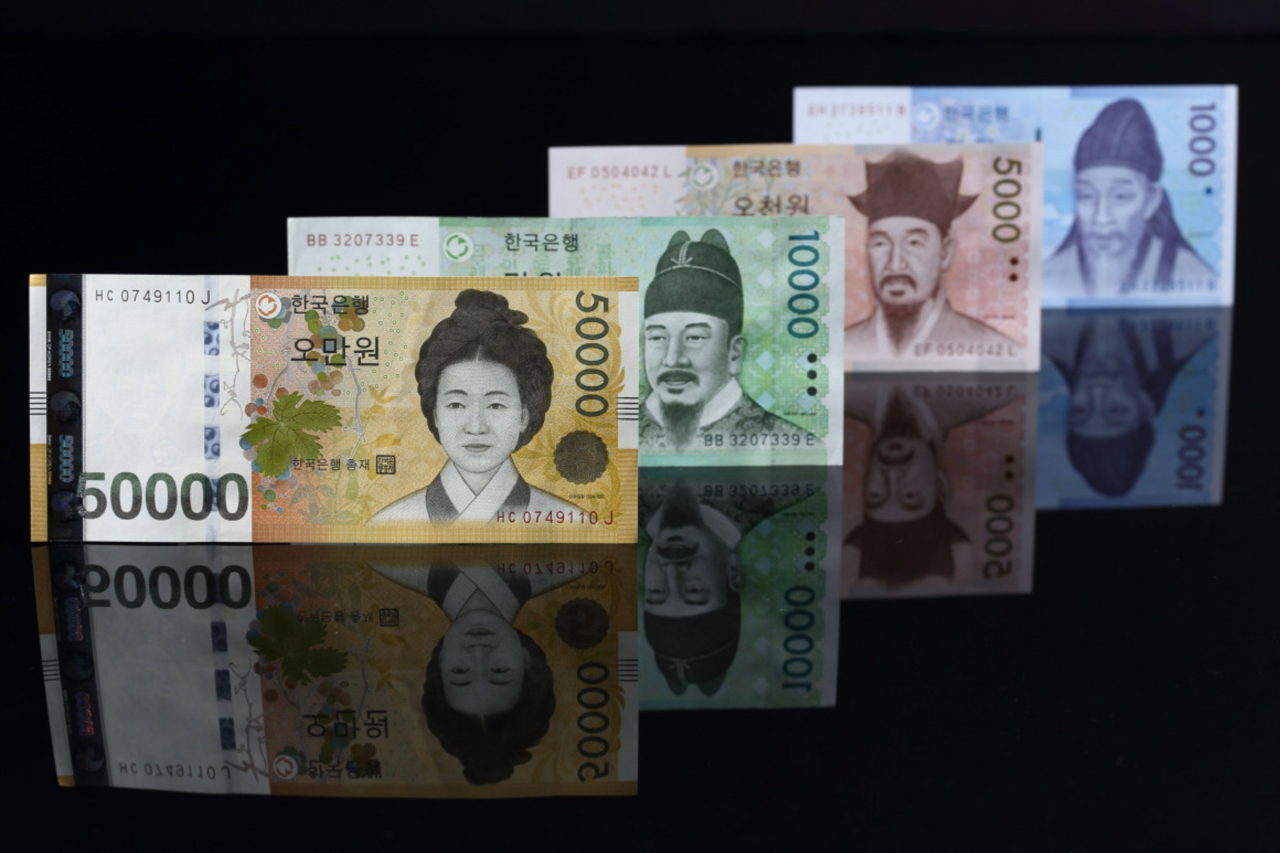 |
(Bloomberg) |
Banknotes with higher face value have a longer life span, with highest denomination here of 50,000 won ($38) presumed to be used for more than 15 years, a central bank report showed Wednesday.
The Bank of Korea announced the results of a study on the average life span of Korean banknotes, making a presumption based on a sample survey of the notes in circulation in 2022.
The results showed 10,000-won and 50,000-won bills have much longer lifetimes than bills of a smaller face value.
The lifetime of 50,000-won bills is presumed to be three times that of 1,000-won bills, 181 months against 70 months. While 10,000-won notes are presumed to be used for 135 months and 5,000-won notes are used up to 63 months.
Fifty-thousand-won bills, first printed in 2009, is the banknote with the largest denomination in Korea. The central bank explained bills with smaller face value have a shorter life span as they are more often used in physical transactions to pay for products or services, or to make change.
The life cycle of a new banknote begins from its public issuance from the Bank of Korea and ends when it is returned to the state institution due to damage.
The life span of banknotes has been on a steady increase, as Korea has been transitioning to a cashless society with an increase of noncash payments and online transactions backed by digital growth. The COVID-19 pandemic has also had an impact, leading to declines in cash withdrawals and use.
More people are paying via credit card and other digital forms of currency, while fewer are accepting cash payments.
According to the central bank's report released in June, cash accounted for only 21.6 percent of individuals' total payment amount in 2021, while credit card and debit cards took up 58.3 percent.
With fewer physical transactions happening, the lifetime of 1,000-won bills increased by nine months from the previous 61 months in 2021. In 2017, the life span of 1,000-won bills was presumed to be 49 months.
According to the BOK, the life spans of Korean banknotes of smaller denominations are longer here compared to those of other nations. It presumed the durability of banknotes here and people's proper use of bills attributed to the relatively longer life span of the banknotes.
For larger banknotes, while the Korean 50,000-won bill can live beyond 15 years, their US and UK counterparts -- $100 and 50-pound bills -- each have longer life spans at about 23 and 41 years, respectively.
Korean banknotes had a longer lifetime than that of the euro as well as Japan’s yen, with the lifetime of a 200-euro banknote being 142 months and a 10,000-yen note being 54 months, attributed to a higher preference for cash payments than in Korea.
However, the central bank added an exact comparison is difficult, as countries have different ways of measuring the life span of their banknotes.
Banknotes with higher face value have a longer life span, with highest denomination here of 50,000 won ($38) presumed to be used for more than 15 years, a central bank report showed Wednesday.
The Bank of Korea announced the results of a study on the average life span of Korean banknotes, making a presumption based on a sample survey of the notes in circulation in 2022.
The results showed 10,000-won and 50,000-won bills have much longer lifetimes than bills of a smaller face value.
The lifetime of 50,000-won bills is presumed to be three times that of 1,000-won bills, 181 months against 70 months. While 10,000-won notes are presumed to be used for 135 months and 5,000-won notes are used up to 63 months.
Fifty-thousand-won bills, first printed in 2009, is the banknote with the largest denomination in Korea. The central bank explained bills with smaller face value have a shorter life span as they are more often used in physical transactions to pay for products or services, or to make change.
The life cycle of a new banknote begins from its public issuance from the Bank of Korea and ends when it is returned to the state institution due to damage.
The life span of banknotes has been on a steady increase, as Korea has been transitioning to a cashless society with an increase of noncash payments and online transactions backed by digital growth. The COVID-19 pandemic has also had an impact, leading to declines in cash withdrawals and use.
More people are paying via credit card and other digital forms of currency, while fewer are accepting cash payments.
According to the central bank's report released in June, cash accounted for only 21.6 percent of individuals' total payment amount in 2021, while credit card and debit cards took up 58.3 percent.
With fewer physical transactions happening, the lifetime of 1,000-won bills increased by nine months from the previous 61 months in 2021. In 2017, the life span of 1,000-won bills was presumed to be 49 months.
According to the BOK, the life spans of Korean banknotes of smaller denominations are longer here compared to those of other nations. It presumed the durability of banknotes here and people's proper use of bills attributed to the relatively longer life span of the banknotes.
For larger banknotes, while the Korean 50,000-won bill can live beyond 15 years, their US and UK counterparts -- $100 and 50-pound bills -- each have longer life spans at about 23 and 41 years, respectively.
Korean banknotes had a longer lifetime than that of the euro as well as Japan’s yen, with the lifetime of a 200-euro banknote being 142 months and a 10,000-yen note being 54 months, attributed to a higher preference for cash payments than in Korea.
However, the central bank added an exact comparison is difficult, as countries have different ways of measuring the life span of their banknotes.







